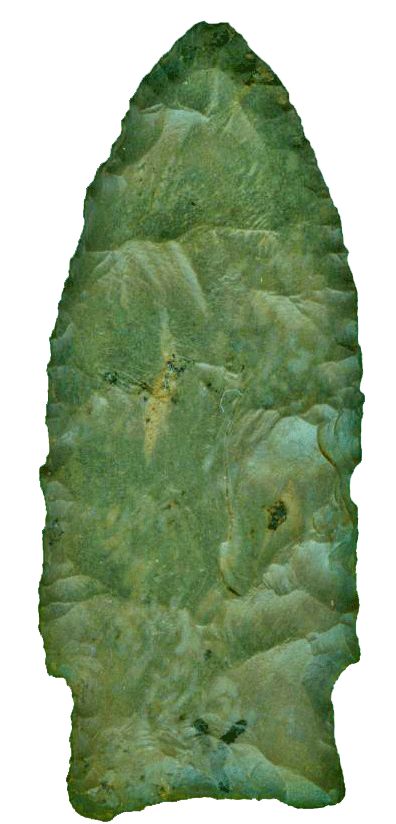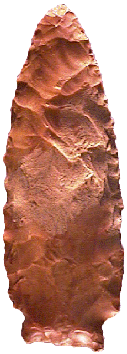



Point Type: BENTON
BROAD STEMMED
Also See: Buzzard Roost Creek, Elk River, Mulberry Creek, Sykes,
Turkeytail
Location: Southeastern to Midwestern United States
Associated Dates:
6000 - 4000 B.P. - Middle to Late Archaic
Morphology: Corner
Notched or Side
Notched
General Description: The Benton Broad Stemmed point is a medium to very large sized, long, point with a straight to excurvate blade edge outline. The Benton Broad Stemmed Point has steeply beveled stem edges. The cross-section may be flattened or biconvex. The shoulders are narrow and may be horizontal or tapered. The shoulders of the Benton type are never barbed. The blade edges are usually excurvate with the distal end being acute. Some Arkansas examples have a steeply beveled edge on one side of each face of the blade. The stem is usually slightly expanded but may be straight. The stem is very broad and short. The stem's side edges are usually incurvate or straight and are beveled. The beveled basal edge is usually straight but may be slightly concave or convex.
The blade and stem exhibit broad, shallow, random flaking. Some broad retouching was used to finish the blade and stem edges. Some specimens show parallel oblique flaking. The stem appears to have been formed by the removal of the corners of the original basal edge. Grinding may or may not be present.
The Benton has been found with Turkeytail points at Benton sites in Mississippi. The type is primarily found in Northern Alabama, Mississippi, Tennessee, Kentucky and southern Illinois as well as with low frequency in the Ohio Valley and into central Indiana. Buzzard Roost Creek points are a widespread sub-type which share the same time period. The Buzzard Roost has a more deeply concave base and may appear to have wide, shallow corner notches. The Benton has an association with the Big Sandy point type at the Eva site in Tennessee. It is likely that the Benton point served as a knife form, which can been seen by the steeply beveled edges resulting from many resharpenings. Narrow forms of the Benton are referred to as the Elk River type.
The size of the Benton point can range from 45 mm to 152 mm in length with the typical point being in the 76 mm range. Average stem thickness is 7 mm with a stem length of 9 mm and stem width of 17 mm. The Benton was named by Madeline Kneberg in 1956 for specimens she found in Benton County, Tennessee.
About The Point Above (Left): The Benton Broad Stemmed point pictured at the top left of this page, was found near Nixon in Hardin County, Tennessee. It is made from a glossy dark and grayish and greenish brown flint material which has rust colored inclusions. It has large parallel flaking scars on each blade face. Overall, the point measures 68 mm in length, is 28 mm wide (at 37 mm from the base) and is only 6 mm thick at mid blade near the shoulders. The base measures 24 mm in width and the concavity of the base is 1.5 mm in depth. The base is not ground however the entire blade, stem and base are bifacially beveled. Catalog Number 12-20-D
About The Point Above (Right): The large Benton Stemmed point pictured at the top right of this page, was found in a creek bed near the town of Ramer, Mcnairy County, Tennessee. It is made from a glossy amber colored jasper or flint with a lighter dull tannish band running through the middle of the blade. Overall, the point measures 92 mm in length, is 31 mm wide (at 29 mm from the base) and is only 9 mm thick at mid blade near the shoulders. The base measures 22 mm in width and the concavity of the base is 1 mm in depth. The base is slighlty ground and the basal edge of the stem and stem sides are beveled. Catalog Number 86-35-D
References: Baker, Cambron & Hulse, Dragoo (c,e), Justice, Overstreet, Perino (1), Powell, Waldorf
© Copyright 1997 - 2008 LITHICS-Net WWW.LITHICSNET.COM
Use your Browser's BACK Button to return to the LITHICS-Net Index.